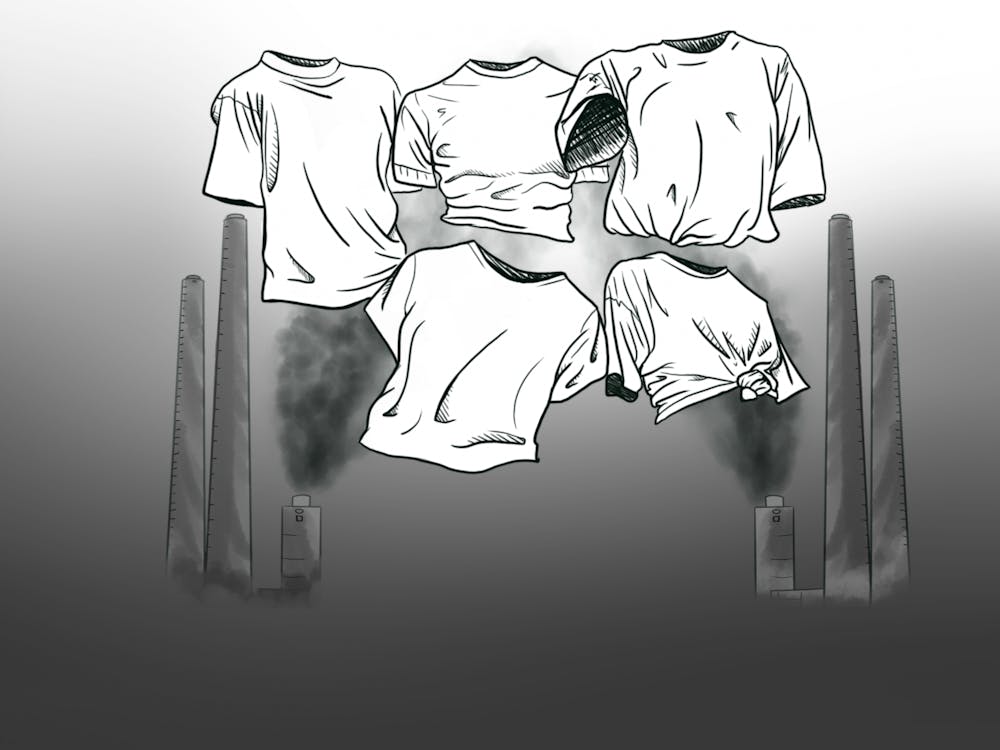College is essentially a trick-or-treat for free t-shirts.
As students join organizations, attend hockey games and mom’s and dad’s weekends and formals, they accumulate closets full of comfy cotton tees with slogans, graphics and hundreds of Miami “M” logos.
But as the concern over sustainability becomes urgent and ever-present, many students are curious — where does all this free stuff come from?
On the wall in the most recent pop-up thrift shop put on by Miami’s Zero Waste Oxford (ZWO) organization, a handmade poster asked shoppers “how much water are you wearing?” It then broke down how much water is used in the production of specific articles of clothing. A t-shirt takes 713 gallons (nearly three years worth of drinking water for one person), a pair of jeans takes 1800 gallons and a new leather jacket needs nearly 8000 gallons.
This is what motivates Halie White, ZWO’s thrift shop manager, to choose thrifting over buying new clothes.
“It’s like, do I need to go buy a new t-shirt?” she said.
She likes how thrifting can take an old garment and “give it a new purpose, and avoid using all those resources.”
ZWO saw other zero waste organizations setting up thrift stores on their campuses and thought it would be a good opportunity for Miami students to be able to buy used without making the trek to Goodwill or Valley Thrift.
“Getting the original stuff to actually put in the store was hard,” White said.
In exchange for volunteer work, ZWO was able to get clothes from ShareFest, a non-profit that takes donations from Miami students during move-out week. What surprised White was how little some of the clothing they received had been worn.
“We found a bunch of brand new stuff with tags and everything,” White said.
Right now, the pop-up thrift shop is open six or seven times a semester in the L&H room inside Armstrong Student Center for one or two weeks at a time. It will open its doors again on November 18th.
Enjoy what you're reading?
Signup for our newsletter
While the thrift shop isn’t open, there are still plenty of ways for college students to be more sustainable in their shopping habits.
Quinn Mills, president of the Sustainable Fashion Initiative at the University of Cincinnati, believes that we should do our best to learn about the brands we buy from.
“I know researching companies isn’t fun when you just want to buy stuff,” she said. “But just try to be more conscious.”
Fast fashion brands tempt consumers with impossibly-low prices, but Mills makes a point to really break that price tag down.
“If you see a shirt for five dollars that’s brand new at a store ... wouldn’t you want to receive more than five dollars to make this?” she said, emphasizing that the company, retail employees, factory owner and garment workers are all splitting that tiny check.
Mills summarized her attitude by simply saying: “Think about who made your clothing.”
Both Mills and White demonstrate just how many sustainable alternatives there are to buying new clothes, but what about getting rid of old clothes?
White pointed out that while many of us might donate to Goodwill, this isn’t the end of your clothing’s environmental impact.
“While donating is great, you also have to think about the other side of it,” White said. “Even when people are donating, they’re still buying new.”
In 2016, Fashionista reported that thrift stores are only able to sell about 20 percent of the donations they receive, while the rest is sold in developing countries. In many of these countries, local garment businesses are struggling to compete with the massive bales of used, mostly American clothing being imported.
Choosing recycling over donating can be hit-or-miss as well. Clothing recycling programs set up by retailers, promising discounts in exchange for any and all clothing donations, don’t do much but promote more consumption. Recycling textiles is a deceptively difficult process, especially as more and more garments are made from mixed-fiber fabrics, like polyester-cotton blends.
According to Industrial Fabrics Association International, these fibers cannot be mechanically separated, meaning recycling facilities often resort to chemicals that damage the fibers and harm the environment when they are disposed of.
Instead of donating or throwing away, White recommends repairing, swapping or borrowing from friends. She used Halloween as an example — a holiday almost dedicated to unrepeatable outfits.
“If you have a costume and needed like, one thing, see if you can borrow it from a friend,” White said.
Miami’s Fashion and Design club holds clothing swaps, where any student can come in, donate old clothes in exchange for tickets, which can be used to “buy” other donated items. King Library also debuted their Makerspace earlier this semester, which includes sewing machines that students can use to repair or hem their clothes.
So, before you order a new t-shirt from your favorite campus club, or “make some noise” at a basketball game for a tee shot out of an air cannon, think about what went into making it, how you’ll use it and what you’ll do when you don’t want it anymore.
There are plenty of ways to get clothes on campus with a smaller carbon footprint. Buying used, swapping with friends, borrowing for special occasions and repairing are all ways to extend the life of our clothes and to give them new purpose when we’re done with them.
As sustainability becomes an unavoidable concern in all of our lives, we can look into our own closets, and the closets of our friends, to see what we can do to help.




